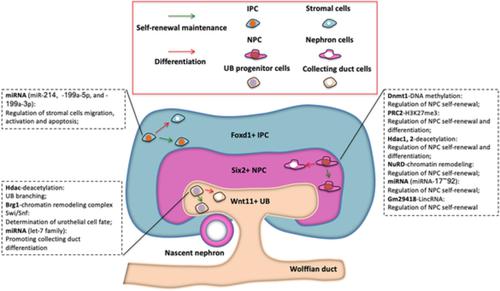当前位置:
X-MOL 学术
›
Stem Cells Transl. Med.
›
论文详情
Our official English website, www.x-mol.net, welcomes your
feedback! (Note: you will need to create a separate account there.)
Epigenetic regulation of kidney progenitor cells.
STEM CELLS Translational Medicine ( IF 5.4 ) Pub Date : 2020-03-12 , DOI: 10.1002/sctm.19-0289 Biao Huang 1, 2 , Zhenqing Liu 3 , Ariel Vonk 1, 2 , Zipeng Zeng 1, 2 , Zhongwei Li 1, 2
STEM CELLS Translational Medicine ( IF 5.4 ) Pub Date : 2020-03-12 , DOI: 10.1002/sctm.19-0289 Biao Huang 1, 2 , Zhenqing Liu 3 , Ariel Vonk 1, 2 , Zipeng Zeng 1, 2 , Zhongwei Li 1, 2
Affiliation

|
The reciprocal interactions among the different embryonic kidney progenitor populations lay the basis for proper kidney organogenesis. During kidney development, three types of progenitor cells, including nephron progenitor cells, ureteric bud progenitor cells, and interstitial progenitor cells, generate the three major kidney structures—the nephrons, the collecting duct network, and the stroma, respectively. Epigenetic mechanisms are well recognized for playing important roles in organism development, in fine‐tuned control of physiological activities, and in responses to environment stimuli. Recently, evidence supporting the importance of epigenetic mechanisms underlying kidney organogenesis has emerged. In this perspective, we summarize the research progress and discuss the potential contribution of novel stem cell, organoid, and next‐generation sequencing tools in advancing this field in the future.
中文翻译:

肾脏祖细胞的表观遗传调控。
不同胚胎肾脏祖细胞群之间的相互相互作用为正确的肾脏器官发生奠定了基础。在肾脏发育过程中,三种类型的祖细胞,包括肾单位祖细胞,输尿管芽祖细胞和间质祖细胞,分别生成三种主要的肾脏结构:肾脏,收集管网和基质。表观遗传机制在生物体发展,对生理活动的精细控制以及对环境刺激的反应中起着重要作用,因此众所周知。最近,已经出现了支持肾器官发生的表观遗传机制的重要性的证据。从这个角度出发,我们总结了研究进展并讨论了新型干细胞,类器官,
更新日期:2020-03-12
中文翻译:

肾脏祖细胞的表观遗传调控。
不同胚胎肾脏祖细胞群之间的相互相互作用为正确的肾脏器官发生奠定了基础。在肾脏发育过程中,三种类型的祖细胞,包括肾单位祖细胞,输尿管芽祖细胞和间质祖细胞,分别生成三种主要的肾脏结构:肾脏,收集管网和基质。表观遗传机制在生物体发展,对生理活动的精细控制以及对环境刺激的反应中起着重要作用,因此众所周知。最近,已经出现了支持肾器官发生的表观遗传机制的重要性的证据。从这个角度出发,我们总结了研究进展并讨论了新型干细胞,类器官,











































 京公网安备 11010802027423号
京公网安备 11010802027423号